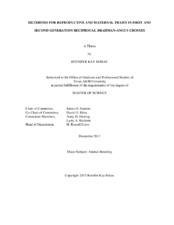| dc.description.abstract | Calf crop born, calf crop weaned, calf birth weight, calf weaning weight, and calf preweaning average daily gain (ADG) were evaluated from 1997 to 2009 in Brahman (B) and Angus (A) straightbred and crossbred cows (n = 194). The objective was to estimate heterosis for F1 and to compare between two groups of F2 females for these reproductive traits. Breed groups included A, B, F1 Brahman-sired (BA; a pair of letters designate the cow’s sire breed and dam breed, respectively) cows (n = 92 purebreds, 53 F1, 49 F2). F2 breed groups included cows sired by AB and out of BA dams (ABBA) and cows sired by BA and out of BA dams (BABA). Data from 2-yr-old females were analyzed separately from cows ages 3-yr-old and older. As 2-yr-olds, Brahman had the lowest calf crop born (0.36 ± 0.07; P < 0.01) and a lower calf crop weaned than every breed group except BABA (0.26 ± 0.08; P < 0.01). Also as 2-yr-olds, BABA had a lower calf crop born (P < 0.05) than BA and ABBA (0.92 ± 0.05 and 0.88 ± 0.08, respectively). As 3-yr-olds and older, BABA had heavier calves (38.74 ± 0.86; P < 0.05) than Brahman, BA, and ABBA, while Brahman had calves with the lightest (P < 0.001) birth weight. As 3-yr-olds, ABBA had the lowest (P < 0.02) calf crop born and weaned (0.28 ± 0.07 and 0.22 ± 0.08, respectively). As 5 to 10-yr-olds, BA weaned heavier calves than Angus, Brahman, and BABA (P < 0.01), and as 10-yr-old and older, ABBA weaned heavier calves than Angus, Brahman, and BABA (P < 0.02). Results suggest that low means of F2 cows sired by Brahman-sired F1 bulls may be responsible for earlier reports that heterosis for reproductive traits was totally lost in that generation. That group (BABA) was represented by a small number of cows for much of the data in later years, because of culling for reproduction, and means for that group may not be representative of the true group performance (i.e., their reproductive performance, as reported in this document, may be inflated). The low performance of BABA as 2-yr-olds and early exit of most of those cows from the project may indicate superior fertility of ABBA F2 cows. | en |


